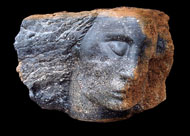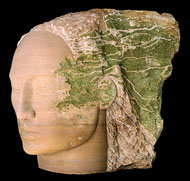Emily Young has emerged as one of Britain’s leading stone sculptors in the last decade. Working with a wide variety of colorful stones, most of them from the UK’s landscapes rather than quarries, she usually carves warriors and angels’ heads and torsos. What especially distinguishes her typical piece, however, is her talent for sliding gracefully from a classical, highly-polished form to the weathered stone from which she carved it. To traditionalists, her work often seems unfinished; but to a growing number of critics, exhibitors, and collectors, it combines a refreshing reverence not only for the human form but also for nature’s carving of the Earth’s bones. Born in London in 1951, Young has lived in Wiltshire, Rome, New York, and California. She was a muralist and painter prior to taking up sculpting in 1985. Her aphorisms in the ensuing piece come, with permission, from her rich webpage:www.emilyyoung.com.
Karl Hufbauer
A piece of stone, a hundred million years old, worked now, could still be here in another hundred million. Who would see it? What would they see?
The stone is hard. It takes diamonds to cut. I can hurl myself at a piece of stone, full strength with hammer and chisel and nothing happens. I do that a few times, and it will accept a small mark. It’s strong, it’s wild, it’s ancient and it has a cold dark heart. It is silent.
The stones exist in an utterly different way to us, slow, silent, and long-lived. And yet, they seem kinds of ancestors to me. They were here before and will be after us. They are made of particles that were born in starbursts, in galactic winds, in that first big bang. They participated more closely in that first singularity. There’s a poetry in them, in their impossibly long slow dance. They show their history, and thereby mine, and the earth’s and the universe’s.
Some stones ring or sing when I knock them with the right thing. The sound they make will tell if the stone is sound, solid, flaw-free, good to work, a quality that can be completely musical.
The exterior of a piece of stone is often a disguise: old, dull, weathered, but after a few hours of polishing, its surface shifts and reveals an extraordinary creation of colours, whirls, stripes, dots - configurations of inhuman complexity and beauty.
Certain stones, when I break them open, give off a quick flash of stink, of sulphur, or petrol, or the ocean, (seaweed? old fish?). I know as I fill my head with the brief whiff of breath that the smell was sealed away two hundred million years ago? four hundred million years ago? six hundred million years ago?
Sometimes I polish a piece of stone and it gradually shows a semblance of water, or the night sky, or flames, or honeycomb, or feathers, or snakeskin, or clouds, or melting ice cream and I am delighted and surprised.
In the past, stone was used to tell stories, to let people know Gods and Queens and Princes, athletes and victors, the famous and the glorious, the vanquished and the foes. Stone was the best material to serve man’s grandest ambitions. I can’t really do that. I don’t want to make the stone my servant: a bigger wilder story is told by the stone itself, of the earth, and the universe. Perhaps I use the human form to let the people see the stone, so it can tell its story, which is part of my story, our story.
The word Angel from the Sanskrit ANJIRAS, means messenger from the gods to man. It seems to me that stones are also messengers from the gods. They are carrying secrets from our past, our creator. The geologists found a better story to explain our origins than the fabulous mix of myth, poetry, and history told in Genesis. The stones whisper to us about things older than we can conceive, gloriously mysterious, yet they are hard, and real; I can touch them with my hands, look into them with a microscope. Here, now, I make my marks, and then they carry on with their journey. Some of these stones are possibly over a billion years old, and it is also possible that they could last into the future for another billion, becoming then a messenger from us as well.
The looks on the faces of the angels are not planned as such, they arrive and surprise me often with their softness and sadness, and strength and calm. But like all good angels, they have a certain graveness, an objectivity, a touch of the infinite, and a certain compassion.
I have a sense of shame for our culture; I wonder if anyone were to find these pieces at some point in the future whether they might get a sense of our good will towards each other and our planet. There’s a hint, a clue for the creatures of the future, that some of us would have liked things to be different.
One of the things that seems important is that whoever sees these angels and warriors and torsos, from whatever culture and from whatever (human) time, should find them readable, recognisable.


